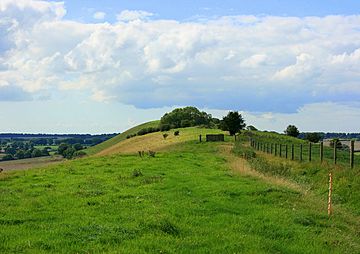Long Knoll facts for kids
Quick facts for kids Long Knoll |
|
|---|---|

Long view of Long Knoll
|
|
| Highest point | |
| Elevation | 288 |
| Prominence | 171 m (561 ft) |
| Parent peak | Beacon Batch |
| Listing | Marilyn |
| Geography | |
| Location | Wiltshire, England |
| OS grid | ST786376 |
| Topo map | OS Landranger 183 |
Long Knoll is a cool hill located in the western part of Wiltshire, England. It's like a long, narrow ridge made of chalk grassland. This ridge stretches for about 1.5 kilometers (almost a mile!). It also marks the border between two local areas: Kilmington to the south and Maiden Bradley to the north.
At its highest point, Long Knoll reaches 288 meters (about 945 feet) above sea level. On a clear day, you can see some amazing sights from the top! These include King Alfred's Tower, Cranmore Tower, the Black Mountains in Wales, and even Glastonbury Tor.
Contents
A Special Place for Nature
Long Knoll is a very important place for nature. It's part of a 34.2-hectare area called the Long Knoll biological Site of Special Scientific Interest. This special area was officially recognized in 1971. It's also part of the larger Cranborne Chase and West Wiltshire Downs Area of Outstanding Natural Beauty. This means the area is protected because of its beautiful landscape and important wildlife.
What Makes it Special?
Long Knoll is the most western part of what used to be a large, flat area made of chalk. It forms a ridge that runs from east to west for about a mile. This ridge stands about 60 meters (200 feet) higher than the land around it.
The hill has different types of plant life depending on which side you look at.
South-Facing Slope Plants
The south-facing side of Long Knoll gets a lot of sun. Here, you'll find a mix of taller and shorter grasses, along with other plants called sedges and forbs (which are non-grassy flowering plants). These plants love chalky soil.
Some common plants you might see here include glaucus sedge, sheep’s-fescue, meadow oat-grass, heath-grass, and common quaking-grass. You can also spot pretty flowers like cowslip, salad burnet, rock-rose, betony, small scabious, and devil’s-bit scabious.
Even rarer chalk grassland plants grow here too! Look out for clustered bellflower, early purple orchid, horseshoe vetch, kidney vetch, and chalk milkwort.
North-Facing Slope Plants
The north-facing side of Long Knoll is different. It has more mosses and tiny plants called bryophytes growing on the closely grazed grass. Here, you'll find grasses like tufted hair-grass, false oat-grass, red fescue, and crested hair-grass.
It's quite unusual to find common valerian on chalky soils, but it grows here! Other interesting plants include autumn gentian, fairy flax, and lots of devil’s-bit scabious.
What is a Marilyn?
Long Knoll is known as a "Marilyn." This is a special term for a hill that stands out quite a bit from the land around it. To be a Marilyn, a hill must have a "topographic prominence" of at least 150 meters (about 492 feet). This means it rises at least that much from the lowest point connecting it to a higher peak.

